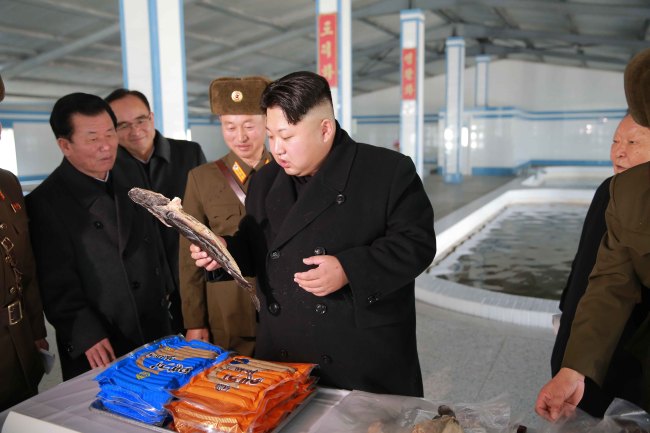Why is N.K. obsessed with Mount Geumgangsan tours?
Analysts say mountain resort would offer hard currency, boost Kim’s tourism drive
By 송상호Published : Dec. 14, 2015 - 21:52
North Korea is keen on resuming the long-stalled tours to Mount Geumgangsan as they would offer a stable source of hard currency, spur efforts to develop tourism on its east coast and eventually enhance the regime’s political legitimacy, analysts said Monday.

Restarting the tour program was one of the thorniest issues at the rare cross-border talks that broke down Saturday as Pyongyang insisted it should be addressed first before finding solutions to other issues -- including Seoul’s priority of families divided by the border.
Analysts said that the cash-strapped state was intent on resuming the tours because the inter-Korean stalemate over the resort has been a stumbling block to North Korean leader Kim Jong-un’s pet project of developing the eastern coastal region into an international tourism zone.
“The biggest reason Pyongyang is preoccupied with the resort is that its resumption would help catalyze Kim’s project to develop tourism in the coastal region of Wonsan that includes the much-vaunted Masikryong Ski Resort,” said Cho Bong-hyun, a senior researcher at the Industrial Bank of Korea.
“Foreign investors have seen the inter-Korean stalemate over the mountain resort as a source of potential investment risks, and they apparently believe the development of tourism in Wonsan would be more profitable when it is connected to the once brisk tourism in Mount Geumgangsan.”
The tours to the mountain resort, once touted as a symbol of cross-border reconciliation and cooperation, were suspended in 2008 when Park Wang-ja, a South Korean tourist, was shot to death for allegedly trespassing into off-limit areas.
Through the tours, which first opened in 1998, the North is estimated to have raked in up to $40 million annually. If cash spent by tourists is included, aside from the entry fees, the North might have earned much more, analysts said, calling the lucrative tours a “cash cow.”
As Pyongyang regards tourism as a key driver of its economic growth and development, its calls for the resumption of the tours have been increasing. During the cross-border talks that were held over the last several years, the North has persistently prioritized resuming the tours.
However, Seoul has demanded that Pyongyang take measures to prevent a recurrence of the 2008 fatal shooting incident, guaranteeing the safety of South Korean tourists as well as that of South Korean properties in the resort facilities.
Seoul is also concerned about the possibility that South Korean tourists could be held hostage if there is an armed clash between the two Koreas. In 2007, when tourism to the resort peaked, some 340,000 South Koreans traveled to the mountain.
The North, on the other hand, claims the issue has been resolved with a verbal promise to prevent a reoccurrence made by then North Korean leader Kim Jong-il to Hyundai Group chairwoman Hyun Jeong-eun during her visit in 2009.
Behind the North’s preoccupation with the tours was its leader’s push to develop tourism, particularly in the region of Wonsan, a city rumored to be where Kim Jong-un was originally from.
Kim has been pushing to develop the city into a world-class tourist destination. In December 2013, the North opened Masikryong Ski Resort, one of Asia’ largest resorts. It further enhanced the tourism infrastructure in the city by refurbishing Kalma International Airport.
The North also reportedly plans to develop a tourism belt linking Wonsan and Mount Geumgangsan by 2025. To this end, it seeks to build hotels, additional ski resorts, golf links, horse-riding tracks and casinos in the area.
On the back of the leader’s focus on tourism, the North is pushing to develop six special tourism districts -- Gaeseong, Mount Geumgangsan, Mount Baekdusan, Mount Chilbosan, Wonsan and Pyongyang.
Tourism projects have been an effective tool to secure foreign currency as other projects involving foreign investors could run afoul of U.N. sanctions that restrict financial dealings with the North due to its pursuit of nuclear and other weapons of mass destruction.
Visible economic achievements from the tourism development drive, led by the young leader, are particularly crucial ahead of the North’s seventh congress of the ruling Workers’ Party slated for next May.
Observers noted that at the congress, which will be the first in 36 years, Kim may need to boast of his own feats rather than those of his late grandfather and father that include the country’s alleged ideological and military strengths.
“At the party congress, the leader may have to enumerate what he has achieved and put forward future projections including how the North’s economy would move forward,” said Chang Yong-seok, a senior researcher at the Institute for Peace and Unification Studies at Seoul National University.
“Thus, a visible boost in tourism due to the resumption of Mount Geumgangsan tours would be a crucial element to brag about (at the congress).”
By Song Sang-ho (sshluck@heraldcorp.com)





![[Herald Interview] 'Amid aging population, Korea to invite more young professionals from overseas'](http://res.heraldm.com/phpwas/restmb_idxmake.php?idx=644&simg=/content/image/2024/04/24/20240424050844_0.jpg&u=20240424200058)











![[KH Explains] Korean shipbuilding stocks rally: Real growth or bubble?](http://res.heraldm.com/phpwas/restmb_idxmake.php?idx=652&simg=/content/image/2024/04/25/20240425050656_0.jpg&u=)

